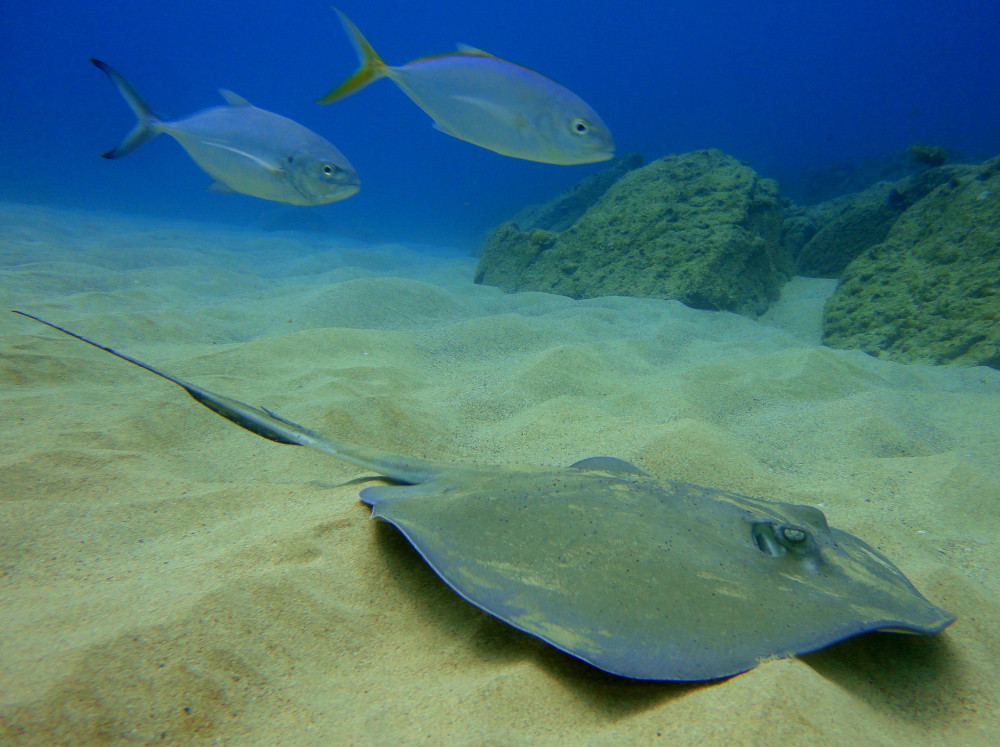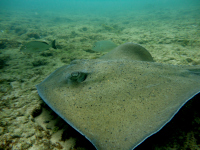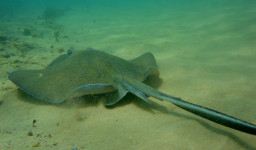Hypanus berthalutzae
Petean, Naylor & Lima, 2020
Classification: Elasmobranchii Myliobatiformes Dasyatidae
Reference of the original description
Integrative taxonomy identifies a new stingray species of the genus Hypanus Rafinesque, 1818 (Dasyatidae, Myliobatiformes) from the Tropical Southwestern Atlantic. Journal of Fish Biology, 97(4), 1120–1142
Integrative taxonomy identifies a new stingray species of the genus Hypanus Rafinesque, 1818 (Dasyatidae, Myliobatiformes) from the Tropical Southwestern Atlantic. Journal of Fish Biology, 97(4), 1120–1142
Types
Hypanus berthalutzae
Holotype: MNRJ: 51963; Paratype: LIRP: 1554; LIRP: 1555; LIRP: 1556; LIRP: 1557; MNRJ: 18910; MNRJ: 17709; MZUSP: 9925; UERJ: 2045; UERJ: 373; UERJ: 1880; UERJ: 2047; UERJ: 2048; UERJ: 2051; USNM: 216825;
Hypanus berthalutzae
Holotype: MNRJ: 51963; Paratype: LIRP: 1554; LIRP: 1555; LIRP: 1556; LIRP: 1557; MNRJ: 18910; MNRJ: 17709; MZUSP: 9925; UERJ: 2045; UERJ: 373; UERJ: 1880; UERJ: 2047; UERJ: 2048; UERJ: 2051; USNM: 216825;
Description :
Citation: Hypanus berthalutzae Petean, Naylor & Lima, 2020: In: Database of modern sharks, rays and chimaeras, www.shark-references.com, World Wide Web electronic publication, Version 12/2025
Please send your images of "Hypanus berthalutzae" to info@shark-references.com

Hypanus berthalutzae Petean, Naylor & Lima, 2020, Fernando de Noronha Archipelago, Brazil © Dr. Tiego Costa

Hypanus berthalutzae Petean, Naylor & Lima, 2020, Fernando de Noronha Archipelago, Brazil © Dr. Tiego Costa
Common names
 Raia Manteiga,
Raia Manteiga,  Raia Prego,
Raia Prego,  Raia de Pedra
Raia de Pedra
 Raia Manteiga,
Raia Manteiga,  Raia Prego,
Raia Prego,  Raia de Pedra
Raia de Pedra
Short Description
Diagnosis after PETEAN, NAYLOR & LIMA, 2020 [28961]: The species H. berthalutzae sp. nov. can be diagnosed by a combination of characters. It is distinguished from non-Hypanus Dasyatidae species that occur in the western Atlantic by the presence of dorsal caudal ridge [vs. absence in Bathytoshia centroura (Mitchill, 1815), vs. dorsal caudal fold in Dasyatis hypostigma (Santos & Carvalho, 2004)]; absence of a w-shaped notch in the central ventral disc (vs. its presence in D. hypostigma); and anterior portion of the disc with angle varying from 125 to 135 and a clear ventral disc [vs. 150 and dark ventral disc in Pteroplatytrygon violacea (Bonaparte, 1832)]. From most Hypanus species, except those from the H. americanus species group, it can be discriminated by the diamond-shaped body with a short snout (vs. a long snout in H. guttatus and H. sabinus); presence of ventral caudal fold and dorsal caudal ridge (vs. ventral and dorsal caudal folds in H. marianae, H. dipterurus, H. say and H. sabinus); and a white spot between the eyes anterior to the precerebral fontanelle (vs. absence of this spot in H. marianae, H. guttatus, H. dipterurus, H. say and H. sabinus). It differs from the species of the H. americanus clade (H. americanus, H. longus and H. rudis) by the presence of sparse black spots on the dorsal disc of live specimens (vs. absent) and by 11 morphometric measurements (Table 2), the most relevant being SPL [18.62% (16.21%–22.47%) of HDL vs. 19.61% (15.85%–32.81%) in H. americanus, 18.37% (17.03%–21.89%) in H. longus and 24.79% (23.55%–26.11%) in H. rudis] and caudal VFH [1.92% (1.37%–2.3%) of DW vs. 1.74% (0.83%–2.83%) in H. americanus, 1.39% (0.75%–2.71%) in H. longus and 1.55% (1.1%–1.81%) in H. rudis]. In male adults of H. berthalutzae sp. nov. and H. americanus, the P2L is smaller than the distance from apopyle to clasper tip (ap–tip), whereas it is larger in H. longus. The measurement P2L/ap–tip is 54.16% in H. berthalutzae sp. nov. [vs. 49.43% (41.78%–56.33%) in H. americanus and 119.44% (113.20%–124.15%) in H. longus].
Diagnosis after PETEAN, NAYLOR & LIMA, 2020 [28961]: The species H. berthalutzae sp. nov. can be diagnosed by a combination of characters. It is distinguished from non-Hypanus Dasyatidae species that occur in the western Atlantic by the presence of dorsal caudal ridge [vs. absence in Bathytoshia centroura (Mitchill, 1815), vs. dorsal caudal fold in Dasyatis hypostigma (Santos & Carvalho, 2004)]; absence of a w-shaped notch in the central ventral disc (vs. its presence in D. hypostigma); and anterior portion of the disc with angle varying from 125 to 135 and a clear ventral disc [vs. 150 and dark ventral disc in Pteroplatytrygon violacea (Bonaparte, 1832)]. From most Hypanus species, except those from the H. americanus species group, it can be discriminated by the diamond-shaped body with a short snout (vs. a long snout in H. guttatus and H. sabinus); presence of ventral caudal fold and dorsal caudal ridge (vs. ventral and dorsal caudal folds in H. marianae, H. dipterurus, H. say and H. sabinus); and a white spot between the eyes anterior to the precerebral fontanelle (vs. absence of this spot in H. marianae, H. guttatus, H. dipterurus, H. say and H. sabinus). It differs from the species of the H. americanus clade (H. americanus, H. longus and H. rudis) by the presence of sparse black spots on the dorsal disc of live specimens (vs. absent) and by 11 morphometric measurements (Table 2), the most relevant being SPL [18.62% (16.21%–22.47%) of HDL vs. 19.61% (15.85%–32.81%) in H. americanus, 18.37% (17.03%–21.89%) in H. longus and 24.79% (23.55%–26.11%) in H. rudis] and caudal VFH [1.92% (1.37%–2.3%) of DW vs. 1.74% (0.83%–2.83%) in H. americanus, 1.39% (0.75%–2.71%) in H. longus and 1.55% (1.1%–1.81%) in H. rudis]. In male adults of H. berthalutzae sp. nov. and H. americanus, the P2L is smaller than the distance from apopyle to clasper tip (ap–tip), whereas it is larger in H. longus. The measurement P2L/ap–tip is 54.16% in H. berthalutzae sp. nov. [vs. 49.43% (41.78%–56.33%) in H. americanus and 119.44% (113.20%–124.15%) in H. longus].
Distribution
from the mouth of the Amazon River to Sao Paulo State coast in Brazil, besides Fernando de Noronha and Rocas Atoll oceanic archipelagos, being delimited at its southernmost distribution by the influence of the La Plata River [28961] Source: www.gbif.org
from the mouth of the Amazon River to Sao Paulo State coast in Brazil, besides Fernando de Noronha and Rocas Atoll oceanic archipelagos, being delimited at its southernmost distribution by the influence of the La Plata River [28961] Source: www.gbif.org
Dentition
Adult teeth cusps acute in males and noncuspidate in females. Teeth larger and in more rows medially, which decrease in size and number laterally. [28961]
Adult teeth cusps acute in males and noncuspidate in females. Teeth larger and in more rows medially, which decrease in size and number laterally. [28961]
Remarks
shark-references Species-ID=16025;
shark-references Species-ID=16025;


















